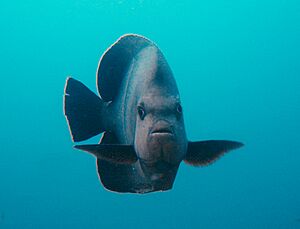Old woman angelfish facts for kids
Quick facts for kids Old woman angelfish |
|
|---|---|
 |
|
| Conservation status | |
| Scientific classification | |
| Synonyms | |
|
Holacanthus rhomboides Gilchrist & Thompson, 1908 |
The old woman angelfish (scientific name: Pomacanthus rhomboides) is a type of fish that lives in the ocean. It's a marine angelfish and belongs to the Pomacanthidae family. You can find this fish in the western part of the Indian Ocean.
Contents
About the Old Woman Angelfish
Adult old woman angelfish are not very colorful. They are mostly a bronze-brown color on the front two-thirds of their body. The back part of their body, near the tail, is a pale bluish-grey.
Young vs. Adult Colors
Young angelfish look quite different from the adults! They are much more colorful. Baby old woman angelfish are mainly black. They have thin, wavy blue and white lines all over their bodies.
Size and Fins
This fish can grow up to about 46 centimeters (18 inches) long. Like other fish, it has special fins. The fin on its back, called the dorsal fin, has 11 to 13 spiny rays and 22 to 25 soft rays. The fin on its underside, called the anal fin, has 3 spiny rays and 21 to 23 soft rays.
Where It Lives
The old woman angelfish makes its home in the western Indian Ocean. You can find it along the coast of South Africa. It lives from Delagoa Bay in Mozambique all the way south to Knysna in the Western Cape province.
Habitat and Life Habits
This angelfish likes to live along shorelines and on rocky reefs. It usually stays in water that is between 5 and 30 meters (about 16 to 98 feet) deep.
Where Young Fish Live
Young old woman angelfish often live in shallow tidal pools. These are small pools of water left behind on the shore when the tide goes out.
What They Eat
Adult angelfish live in small groups close to the coast. They mostly eat algae, which are like tiny ocean plants. They also munch on small creatures that live on the seafloor, called benthic invertebrates. Sometimes, they will swim closer to the surface to eat plankton, which are tiny floating organisms.
How It Got Its Name
The old woman angelfish was first officially described in 1908. Two scientists, John Dow Fisher Gilchrist from Scotland and William Wardlaw Thompson from South Africa, gave it the scientific name Holacanthus rhomboides at first.
Meaning of the Name
The name rhomboides means "rhombus-like." A rhombus is a shape like a diamond. This name probably refers to the fish's body shape, which is deep and almost square-like.
Why It's Rare in Aquariums
This angelfish is very rarely seen in home aquariums. This is because the places where it lives do not overlap with the main areas where fish are collected for the aquarium trade in Africa. So, it's not often caught and sold to fish enthusiasts.



